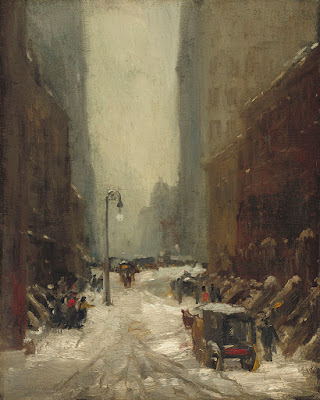If President Trump wants to buy something, he should buy back Rockwell Kent’s paintings from Russia.
 |
|
Cloverfields, 1939-40, Rockwell Kent, courtesy Mead Art Museum at Amherst College.
|
In his mid-40s, Rockwell Kent moved to a working Adirondack dairy farm that he called Asgaard. He lived and painted there until his death in 1971. The name came from Nordic mythology. It roughly corresponds to Old Norse for “Garden of the Gods,” and is an apt description of the place. Ringed by the High Peaks of the Adirondacks, with fast-moving rivers and streams, this area has been a draw for outdoorsmen and artists for nearly two hundred years.
Asgaard is located in the small town of Au Sable Forks, New York. “And there, westward and heavenward, to the high ridge of Whiteface northward to the northern limit of the mountains, southward to their highest peaks, was spread the full half-circle panorama of the Adirondacks. It was as if we had never seen the mountains before,” wrote Kent.
 |
|
Au Sable River, Winter: Adirondacks, 1960, Rockwell Kent, courtesy the Hermitage.
|
In addition to being Kent’s home, Asgaard was also a working dairy farm. It was acquired by David Brunner and Rhonda Butler in 1988 and brought back into production in 2003. Here in the Northeast, fallow land rapidly reverts to forest, so not only were Brunner and Butler saving an historic farm, they were saving a view.
Rockwell Kent’s reputation as a painter languished in the later 20th century. “Kent, if not a towering talent in American art, was a prolific man who made a good living not only as a painter but also as a commercial artist; muralist; designer of fabric, pottery and jewelry; architect, and Adirondack dairy farmer,” wrote Judith H. Dobrzynski in the New York Times in 1999.
 |
|
Summer Day, Asgaard, 1950, Rockwell Kent, courtesy the Hermitage.
|
His politics didn’t help. He was an outspoken socialist and Communist sympathizer. Called to testify before Senator Joseph McCarthy’s subcommittee in 1953, Kent stubbornly pleaded the Fifth Amendment. He later said he’d never been a member of the Communist Party, but he’d effectively ruined his career. Suddenly, he was anathema to galleries and museums.
Kent had donated 80 paintings and 800 prints and drawings to the Farnsworth Art Museum in Rockland, ME. They backtracked and rejected the work. Stung, Kent donated the entire collection to the Soviet Union. Many of his works from the Adirondacks were in this gift, which made them unknown to two generations of American art critics. It took the fall of the Soviet Union and the internet to make them visible again.
 |
|
Road to Asgaard: Adirondacks, 1960, Rockwell Kent, courtesy the Hermitage.
|
Kent was out of step artistically, too. He was a stubborn realist in the age when abstract expressionism was all the rage. He was an indefatigable plein air painter, traveling to remote places like Greenland, Tierra del Fuego, Alaska and Maine. “Go before nature, use your eyes, and then paint what you see,” was his credo.
His work is ultimately spiritual. “His painting is a proclamation of the rights of man, of the dignity of man, of the dignity of creation. It is his belief in God,” wrote Robert Henri.











